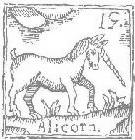
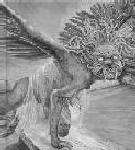
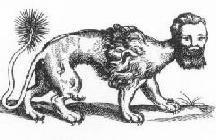






In sad news, Gian Carlo Menotti passed away on February 1, 2007, in Monaco, at the age of 95. You can find a full story here.
Was born in Italy in 1911. He began composing music at age 7, and
began formal training at 12. He immigrated to the U.S. with his
mother at age 17. His relationship with Samuel Barber began soon
thereafter and is well chronicled. Further (and much more complete)
biographical information can be found at the following locations:
http://www.schirmer.com/composers/menotti/bio.html
http://www.schirmer.com/composers/menotti/essay.html
http://www.classical.net/music/comp.lst/menotti.html
http://www.indegayforum.org/articles/varnell69.html
http://www.xrefer.com/entry/242607
http://www.karadar.net/Dictionary/menotti.html
http://www.users.globalnet.co.uk/~mcgoni/menotti.html


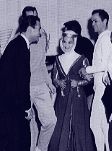
|
The piece was commissioned by the Elizabeth Sprague Coolidge Foundation, in the Library of Congress, Washington, D.C., and was first performed under the sponsorship of the Foundation in the Library of Congress (in the Coolidge Auditorium) on 21 October 1956. The New York premiere, presented by the New York City Ballet, took place on 15 January 1957, at the New York City Center of Music and Drama. The picture at left shows Menotti directing the Washington Opera in a rehearsal of The Unicorn... in 1957. |
THE STORY:
The text focuses on a well-to-do but eccentric poet who lives in a
castle. It presents his life in three stages: his youth, middle, and
old age. Three unusual pets symbolize these stages -- a unicorn, a
gorgon, and a manticore (see descriptions below). As an aside, the
behavior of these beasts mimics Menotti's own career (and his idea of
artists in general). The unicorn, the young artist, is capricious,
foolish, and susceptible to temptation, but beautiful all the while.
The gorgon, the artist at mid-life, having achieved some success, is
loud, proud, and fearless, ignores the critics, and can be quite ugly
(and, naturally, in reaching this stage, the unicorn [youth] dies off
[or, taken another way, is actually killed off by mankind and its
critics, i.e., youthful creativity is worn down by criticism and
fickleness]). (Note that Menotti had a well-documented constant fight
with literary and musical critics - one critic dismissed him as "the
Puccini of the poor" to which he countered "Better that than 'the
Boulez of the rich' ". He doesn't hide his dislike for critics in this
piece, calling them 'critical crickets', and 'sententious cows'.) The
manticore, the aging artist, is lonely (payment for his haughty
behavior as the gorgon!), and shy, avoiding contact as much as
possible. He regrets his earlier ways, and although he means well,
he often hurts those around him, having been embittered by the years
of criticism. In passing into old age, the gorgon of middle age dies
off (or, again, is killed off by mankind).
In the piece, each appearance of the poet in the town with a new beast
sets off a series of events. When he first appears with his unicorn
on a Sunday stroll, the astonished townsfolk ascribe this oddity to
insanity. Yet the sheer novelty of the unicorn compels at least the
Countess to overcome her amazement and persuade the Count to obtain a
unicorn for them. The townsfolk soon follow suit, obtaining unicorns
of their own. The next Sunday, the strange man appears, this time not
with the unicorn, but with the hideous gorgon. This further astonishes
the townsfolk who take the unicorn for dead, apparently murdered by the
strange man. The arrival of the new creature gives the Countess the
opportunity to dispense with her unicorn (it has grown commonplace) and
to acquire a gorgon. To follow this new fashion, the townsfolk kill
their own unicorns. Not surprisingly, the same set of events takes
place when a manticore appears instead of the gorgon on the man's next
Sunday walk. But the subsequent disappearance of the manticore so
scandalizes the townsfolk that they proceed directly to the castle to
pass judgement on the strange man. When they arrive, however, they
find him on his deathbed, with the three creatures at his side.
Deriding all those who blindly live through social conventions, all
those who value things blest only by fashion, he finally suggests that
only in the artist will society find redemption, for it is the artist
who lives by and for truth.

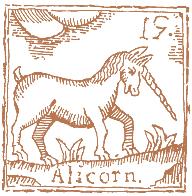
|
The unicorn is a well recognized mythological creature, but many may
be surprised to find that it was not always considered a kind,
benevolent, peaceful creature. From Pliny's description in
Natural History : "a very ferocious beast, similar in the rest of
it's body to a horse, with the head of a deer, the feet of an
elephant, the tail of a boar, a deep, bellowing voice, and single
black horn, two cubits in length, standing out in the middle of its
forehead." Despite this, Menotti was almost certainly intending the
more gentle version in this piece. Some decent unicorn places on the
web: http://www.unicorn-dream.co.uk/unicorn2.html http://www.unicorncollector.com/legends.htm |
The gorgon is much less recognized than the unicorn, and in fact, there are 2 very distinct versions of this beast.
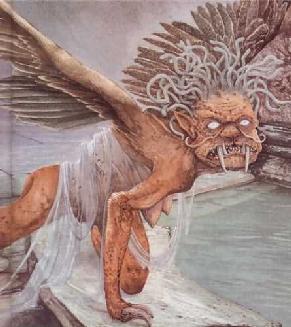
|
The first, and more common one, is represented by Medusa of Greek
mythology. According to the myth, the gorgons were three sisters,
daughters of the ancient (pre-titan) gods Phorkys and Keto. The
sisters Sthenno and Euryale were immortal but the third, Medusa, was
mortal. The gorgons were monsters with serpents for hair, brazen
claws and staring eyes whose glance turned men to stone. Their
wings were of gold, their bodies were covered with impenetrable
scales and their teeth were as long as the tusks of wild boars.
Medusa was called the gorgon or simply, gorgon.
Web info: http://www.arthistory.sbc.edu/imageswomen/papers/kottkegorgon/gorgons.html http://www.panphobia.com/monsters/monsters_medusa.htm http://www.monstrous.com/medusa.htm http://academic.brooklyn.cuny.edu/art/koslow/essays/medusa/text.htm |
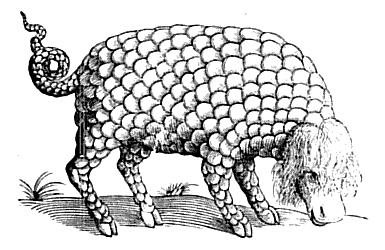
|
The second, less common one, is a ferocious beast which is more like
an ox, or gnu. This description was propagated by Edward Topsell in
his 1607 book The Historie of Foure-Footed Beastes . An
excerpt: "It is a feareful and terrible beast to beholdd, it hath
high and thicke eie lids, eies not very great, but much like an Oxe
or Bugils, but all fiery-bloudy, which neyther looke directly
forwarde, nor yet upwards, but continuallye downe to the earth, and
therefore are called in Greeke Catobleponta. From the crowne of their
head downe to their nose they have a long hanging mane, which maketh
them to looke fearefully. It eateth deadly and poysonfull hearbs,
and if at any time he see a Bull or other creature whereof he is
afraid, he presently causeth his mane to stand upright, and being so
lifted up, opening his lips, and gaping wide, sendeth forth of his
throat a certaine sharpe and horrible breath, which infecteth and
poysoneth the air above his head, so that all living creatures which
draw in the breath of that aire are greevously afflicted thereby,
loosing both voyce and sight, they fall into leathall and deadly
convulsions. For more on this: http://penelope.uchicago.edu/oddnotes/topsellgorgon.html |
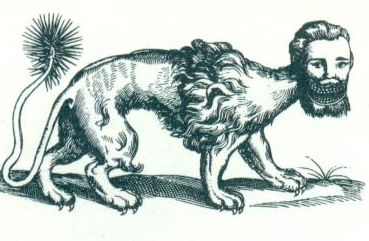
|
There seems to be little dispute about the manticore - nearly always
a quite ferocious beast in literature. One description: "It has a
red lion's body; a human face, ears and blue eyes; and a voice like
the mingling of panpipes and trumpet. But the distinctive and
terrible features are three rows of teeth in each jaw, a fatal sting
like a scorpion's in the end of the tail, and poisoned spines along
the tail which may be shot like arrows in any direction. It is
exceedingly swift, with leaps so powerful that the loftiest objects
and largest spaces cannot hold it. Finally, it is a man-eater."
Menotti's manticore seems to be much gentler, however. For more
information: http://users.vianet.ca/~grizelda/fur/mard.html |

Here are the recordings that I know about. If you know of others, let me know!
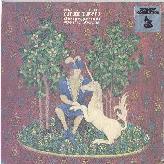
|
LP album (University of Michigan Recordings SM0012) Ensemble: University of Michigan Chamber Choir Conductor: Thomas Hilbish Year: 1979 Note: this album was nominated for a Grammy Award in 1980! |
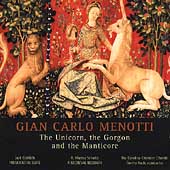
|
CD (ALBANY RECORDS 452) Ensemble: Carolina Chamber Chorale + Empire Chamber Concert Ensemble Conductor: Timothy Koch Year: 2001 - but actually recorded in 1992 You can see a comparative list of places to purchase it online at: shopping.yahoo.com |
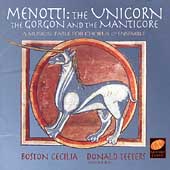
|
CD (NEWPORT CLASSICS 85621) Ensemble: Boston Cecelia Ensemble Conductor: Donald Teeters Year: 1997 You can see a comparative list of places to purchase it online at: shopping.yahoo.com |
For a pretty good list of lots more online classical CD stores, check out: http://indigo.ie/~pamolo/faq.html

Here are some performances that I know about. If you know of others, let me know!
Of course I have to start with our own (New Mexico Tech Chamber
Choir) performance, which was on May 9-11, 2003.
the concert poster
the program, Word version
the program, PDF version
And then some others that I've found by googling or from direct contact by performers:
May 11 & 13, 2007 - Nevada Opera
Below are electronic files for the piece. These files are for use by
the NMTech Chamber Choir members only, and are not for redistribution,
resale, or reuse.
The files noted as 'Recording' below are from the Albany Records CD
above.
The part files were created by the
ScoreWriter software (as an aside - it's not great software, but
alot cheaper [~$50] than
Overture, [~$350]
Finale, [~$600 {$300 educational}]
Sibelius, [~$600 {$300
educational}] etc...!). I put in the notes, and have it create the
MIDI files for me. The MIDI files are all pretty small - but you need
to be able to play them on your computer. Most (all?) PCs running
windows or Mac can do this, but Linux/Unix/Solaris often cannot.
If you are on a Linux box, try the
Playmidi package
(find some help
here ) or the
Timidity package (find some help
here ), or one of the
xmms plugins. Or, just try a google search with 'Linux' and
'MIDI' in it, and follow the links. If you're still having trouble,
send me an email.
Some caveats about the part files:
- There are undoubtedly mistakes in them! Let me know
if you find any.
- The tempos are mine, and Doug can change them
at will for rehearsal/performance.
- Dynamics are not included.
- Even valued tuplets aren't done quite right
(stupid software - grrr...). They are close, but be warned.
- Some of the individual parts aren't there yet -
I just haven't gotten them done yet. The parts for the movements
we are doing this winter are there though (Introduction and
Madrigals 1, 2, and 5)...
INTRODUCTION
| Recording | MP3 (0.838 MB) |
| All parts | MIDI |
| Soprano parts | MIDI |
| Alto parts | MIDI |
| Tenor parts | MIDI |
| Bass parts | MIDI |
| Recording | MP3 (1.885 MB) |
| Recording | MP3 (1.665 MB) |
| All parts | MIDI |
| Soprano parts | MIDI |
| Alto parts | MIDI |
| Tenor parts | MIDI |
| Bass parts | MIDI |
| Recording | MP3 (1.510 MB) |
| Recording | MP3 (2.188 MB) |
| All parts | MIDI |
| Soprano parts | MIDI |
| Alto parts | MIDI |
| Tenor parts | MIDI |
| Bass parts | MIDI |
| Recording | MP3 (0.666 MB) |
| Recording | MP3 (2.238 MB) |
| All parts | MIDI |
| Soprano parts | MIDI |
| Alto parts | MIDI |
| Tenor parts | MIDI |
| Bass parts | MIDI |
| Recording | MP3 (2.546 MB) |
| All parts | MIDI |
| Soprano parts | MIDI |
| Alto parts | MIDI |
| Tenor parts | MIDI |
| Bass parts | MIDI |
| Recording | MP3 (1.325 MB) |
| Recording | MP3 (1.328 MB) |
| All parts | MIDI |
| Soprano parts | MIDI |
| Alto parts | MIDI |
| Tenor parts | MIDI |
| Bass parts | MIDI |
| Recording | MP3 (2.802 MB) |
| All parts | MIDI |
| Soprano parts | MIDI |
| Alto parts | MIDI |
| Tenor parts | MIDI |
| Bass parts | MIDI |
| Recording | MP3 (2.724 MB) |
| All parts | MIDI |
| Soprano parts | MIDI |
| Alto parts | MIDI |
| Tenor parts | MIDI |
| Bass parts | MIDI |
| Recording | MP3 (3.232 MB) |
| Recording | MP3 (1.662 MB) |
| All parts | MIDI |
| Soprano parts | MIDI |
| Alto parts | MIDI |
| Tenor parts | MIDI |
| Bass parts | MIDI |
| Recording | MP3 (0.974 MB) |
| All parts | MIDI |
| Soprano parts | MIDI |
| Alto parts | MIDI |
| Tenor parts | MIDI |
| Bass parts | MIDI |
| Recording | MP3 (1.075 MB) |
| Recording | MP3 (2.487 MB) |
| All parts | MIDI |
| Soprano parts | MIDI |
| Alto parts | MIDI |
| Tenor parts | MIDI |
| Bass parts | MIDI |
| Recording | MP3 (1.449 MB) |
| Recording | MP3 (0.882 MB) |
| All parts | MIDI |
| Soprano parts | MIDI |
| Alto parts | MIDI |
| Tenor parts | MIDI |
| Bass parts | MIDI |
| Recording | MP3 (1.981 MB) |
| All parts | MIDI |
| Soprano parts | MIDI |
| Alto parts | MIDI |
| Tenor parts | MIDI |
| Bass parts | MIDI |
| Recording | MP3 (3.249 MB) |
| All parts | MIDI |
| Soprano parts | MIDI |
| Alto parts | MIDI |
| Tenor parts | MIDI |
| Bass parts | MIDI |

Last Modified on 2007-Feb-26